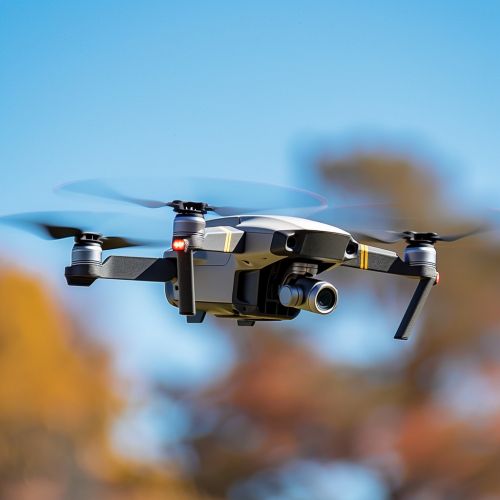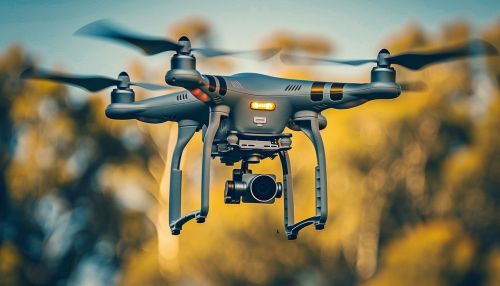Drone Technology: Difference between revisions
(Created page with "== Introduction == Drone technology refers to the use of unmanned aerial vehicles (UAVs), which are remotely piloted or autonomously programmed. These devices have seen a significant rise in popularity and usage in various sectors such as military, commercial, recreational, and scientific fields. The development and advancement of drone technology have been driven by the need for increased efficiency, reduced human risk, and the ability to access hard-to-reach areas. <...") |
No edit summary |
||
| (One intermediate revision by the same user not shown) | |||
| Line 3: | Line 3: | ||
Drone technology refers to the use of unmanned aerial vehicles (UAVs), which are remotely piloted or autonomously programmed. These devices have seen a significant rise in popularity and usage in various sectors such as military, commercial, recreational, and scientific fields. The development and advancement of drone technology have been driven by the need for increased efficiency, reduced human risk, and the ability to access hard-to-reach areas. | Drone technology refers to the use of unmanned aerial vehicles (UAVs), which are remotely piloted or autonomously programmed. These devices have seen a significant rise in popularity and usage in various sectors such as military, commercial, recreational, and scientific fields. The development and advancement of drone technology have been driven by the need for increased efficiency, reduced human risk, and the ability to access hard-to-reach areas. | ||
[[Image:Detail-77645.jpg|thumb|center|A drone in flight, showing its propellers and camera.|class=only_on_mobile]] | |||
[[Image:Detail-77646.jpg|thumb|center|A drone in flight, showing its propellers and camera.|class=only_on_desktop]] | |||
== History and Development == | == History and Development == | ||
Latest revision as of 21:33, 6 May 2024
Introduction
Drone technology refers to the use of unmanned aerial vehicles (UAVs), which are remotely piloted or autonomously programmed. These devices have seen a significant rise in popularity and usage in various sectors such as military, commercial, recreational, and scientific fields. The development and advancement of drone technology have been driven by the need for increased efficiency, reduced human risk, and the ability to access hard-to-reach areas.


History and Development
The concept of drone technology can be traced back to the mid-19th century when Austrians used unmanned balloons filled with explosives as a form of attack during the Venetian siege. However, the modern development of drones began in the early 20th century. During World War I, the U.S. developed the Kettering Bug, an unmanned aerial torpedo that would fly to a predetermined destination. Despite these early developments, drone technology did not gain significant traction until World War II and the Cold War, where they were used for training anti-aircraft crews and surveillance.
The advancement of drone technology has been significantly influenced by the development of digital technology. The introduction of GPS technology in the 1990s, for instance, made it possible for drones to be accurately guided, greatly increasing their utility and efficiency.
Types of Drones
Drones come in various types, each designed for a specific purpose. The most common types of drones include:
- Multi-Rotor Drones: These are the most common type of drones used for commercial and recreational purposes. They are ideal for aerial photography, film-making, and surveillance due to their ability to hover in one place.
- Fixed-Wing Drones: Unlike multi-rotor drones, fixed-wing drones cannot hover. Instead, they glide along a set path and are ideal for aerial mapping, inspections, and long-range surveillance.
- Single Rotor Drones: Resembling mini helicopters, single rotor drones are more efficient than multi-rotor drones. They are often used for heavy lifting and industrial tasks.
- Hybrid VTOL Drones: These drones combine the benefits of fixed-wing and multi-rotor drones. They can take off and land vertically like a multi-rotor drone and fly horizontally like a fixed-wing drone.
Applications of Drone Technology
Drone technology has a wide range of applications across various sectors:
- Military: Drones have been extensively used in the military for surveillance, target acquisition, and in some cases for airstrikes. They provide a significant advantage in terms of reducing risk to human life and increasing operational efficiency.
- Agriculture: In agriculture, drones are used for crop monitoring, irrigation, crop spraying, planting, and crop health assessment.
- Delivery and Logistics: Companies like Amazon and UPS are testing and using drones for package delivery. This method of delivery can be faster and more cost-effective.
- Emergency Services: Drones are used in search and rescue operations, firefighting, and law enforcement. They can access hard-to-reach areas and provide real-time video feed.
- Media and Entertainment: Drones are used for filming, journalism, and live broadcasting. They provide unique perspectives and can operate in areas where it is difficult for traditional camera equipment.
- Scientific Research: Drones are used in wildlife tracking, archaeological sites exploration, atmospheric research, and geological surveying.
Future of Drone Technology
The future of drone technology looks promising with continuous advancements in technology. The integration of artificial intelligence with drones is expected to make them more autonomous and efficient. The use of drones in delivery and logistics is expected to become more prevalent. Moreover, the development of drone traffic management systems is anticipated to facilitate the integration of drones into the national airspace system.
